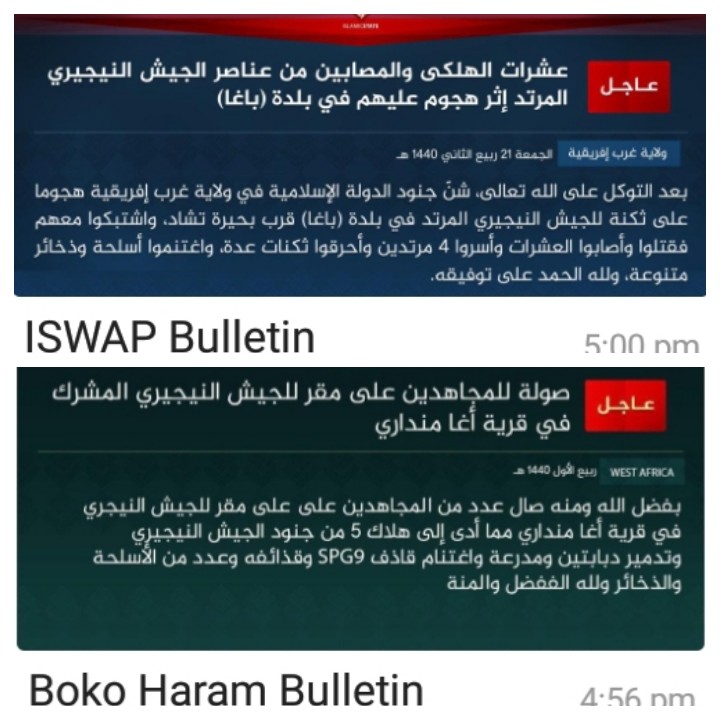There are several ironies that have dogged the war on terrorism in Nigeria. For those who closely follow the conflict, both the Islamic State West Africa and its progenitor, Boko Haram, are still in existence is all thanks to the Nigerian Army. Hard to believe, yet at the point between 2016 and 2017 when ISWAP and Boko Haram fought fiercely, exerting so much energy and resources to neutralize themselves it was the Army that inexplicably built a buffer between the enemies, in effect, restraining them from taking further steps at self-destructing.
Old Marte and New Marte are separated by a paved road. While ISWAP controlled Old Marte and all the territory up to the border with both Chad and Niger Republics, Boko Haram controlled New Marte and the territory towards Central and Southern Borno, and stretched towards the border with Cameroon.
However, in a rather curious step, the Nigerian Army decided to create a base in New Marte, just in-between the two insurgent groups. That singular move by the Military offered a lifeline to the foes who would later exert all of their hostile energies and resources against the Military barely 15 months afterwards. As at result, ISWAP fighters have crossed over and expanded their footholds further into central and southern Borno, with their eyes now set on Bama, Gwoza and the Sambisa forest, Boko Haram’s turf.
Given the manner in which ISWAP broke away from Boko Haram there were bound to be grievances and hostility in their relationship. Boko Haram, under Abubakar Shekau had been midwifing a strategic relationship with the Khalifa, Abu Bakr al-Baghdadi of the Islamic State in Iraq and Syria. Sources within the sect say that Shekau’s trusted “protégée,” Abu Musab Albarnawi, son of the slain founder of Boko Haram was directly managing the process.
Under the surface, however, a plot was heating up within the sect targeted against the leadership of Shekau, and Albarnawi was the arrowhead of the insurrection. Before his disloyalty could be found out, said insiders, he had led a formidable corps of the field commanders of Shekau’s forces into a splinter force. Because of the nature of the structure of the sect, external and inter-unit engagements and information are never freely shared. Two different units or cells of the sect may not know or inquire into what each is doing.
For this reason, apparently Albarnawi was the only one directly in conversation with IS in Iraq and Syria. Following the split, all institutional memory and references to the process were swiftly slit from Boko Haram. The newly conceived sect, taking advantage of this, guided its conversation with IS in a manner that recognized it as the only one of reference and note in West Africa. Apparently to fully milk the situation the new sect took up the name Wilayat West Africa otherwise known as Islamic State West Africa, ISWAP. The sense of betrayal, grief and animosity that came with ISWAP’s emergence snowballed into a fierce contest over ideology and territory. The fight that engulfed both sects from 2016 into late 2017 was so vicious it seemed to close watchers that the two forces would finally cancel each other out irretrievably and finally usher the peace that had eluded Borno state and the North East for several years.
Notwithstanding that Boko Haram has been living in the shadows of ISWAP, it has consistently presented itself implicitly as an affiliate of IS in Iraq and Syria. While ISWAP with access to a massive cache of military hardware used the IS communication template and has responded submissively to doctrinal and operational reprimands from leaders of the IS. Reliable sources also reported the presence of IS advisers in the region and growing communication platforms between Lake Chad and Raqqa. However, a member of Boko Haram recently asserted, concerning the sect’s affiliation with IS, that “we have not renounced our oath of allegiance to the Khalifa, al-Baghdadi and neither did IS come out to denounce it.”
It is not difficult to see which of the two sects is milking the IS connection the most. Unlike Shekau’s group that seems to mimic IS template, the ISWAP attacks and operations have consistently been featured in the Amaq News Agency, the official media mouthpiece of IS. Abdulbasit Kassim, the author of Boko Haram Reader brings interesting insights, “Boko Haram bulletins have a lot of errors in Arabic, which probably show that their bulletins are locally crafted and not embedded with IS bulletins that produced that of ISWAP.”

Besides, several IS publications refers to Abu Musab led faction as “soldiers of the Islamic State West Africa,” and IS have all along snubbed Boko Haram, yet the group has not stopped trying. ISWAP refers to Boko Haram as Khawarij, a name given to those accused of disrupting the unity of Muslims, Shekau too, used the term to describe ISWAP, but curiously, he has not openly called IS Kwawarijites. To further underline the seeming cold shoulders from IS towards Boko Haram, Shekau in 2016 in an audio exchange with the trio of Abu Musab, Mamman Nur and Abu Fatima lamented that he had written eight letters to IS in Raqqa and had received no response.
By Ahmad Salkida

Your articles are always informative and detailed. This indicates you have insider information. But what surprises me is why the authority Choose not to work with you.
Pingback: Recent Analyses and Articles on Boko Haram | Sahel Blog